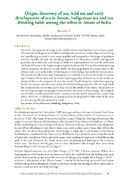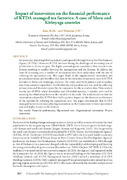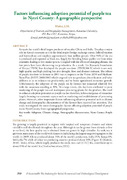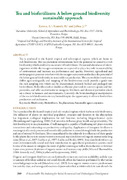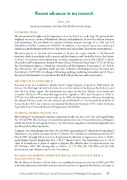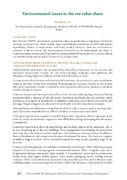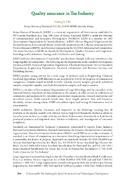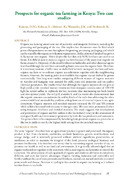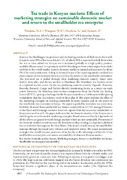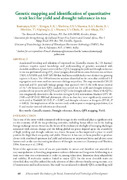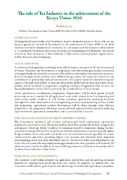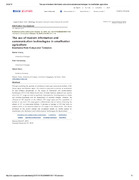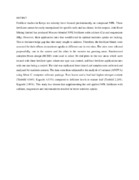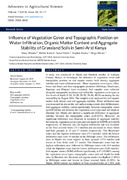Browsing Department of Agricultural Resources and Economics by Issue Date
Now showing items 1-20 of 34
-
EFFECTS OF WEATHER ON THRIPS POPULATION DYNAMICS AND ITS IMPLICATIONS ON THE THRIPS PEST MANAGEMENT
(Karatina University, 2008-06-30)Onion thrips, Thrips tabaci Lindeman, is the most destructive insect pest of the onion crop, Allium cepa L. worldwide. Both larvae and adults attack the onion crop at all stages of its growth, resulting in reduction of ... -
Origin, discovery of tea, wild tea and early development of tea in Assam, indigenous tea and tea drinking habit among the tribes in Assam of India
(2015)Tea is the most popular beverage in the world and its consumption is next only to water. The scientific findings on its health beneficial properties and as a drink of general wellbeing are contributing to make it even ... -
Impact of innovation on the financial performance of KTDA managed tea factories: A case of Meru and Kirinyaga counties
(2015)Kenya is a key player in global tea industry and especially through Kenya Tea Development Agency (KTDA). However, KTDA has been facing the challenges of increasing cost of production in the recent past. The higher processing ... -
Factors influencing adoption potential of purple tea in Nyeri County: A geographic perspective
(2015)Kenya is the world’s third largest producer of tea after China and India. Tea plays a major role in Kenya’s economy as it is the third major foreign exchange earner, behind tourism and horticulture and employs approximately ... -
ICT and technological development in advancing tea research in Kenya
(2015)Agriculture is the backbone of the Kenyan economy and it is constantly influenced by changes in technology. Because of the rapid development of ICT in the world, each organization or person has to concern their products ... -
Tea and biofertilizers: A below ground biodiversity sustainable approach
(2015)Tea is produced in the humid tropical and sub-tropical regions, which are home to rich biodiversity. The tea plantation environments have the potential to conserve a rich biodiversity which could serve as a source of ... -
Addressing the education and training needs of the tea sector in Kenya: The case of the School of Agriculture and Biotechnology at Karatina University
(2015)In Kenya, personnel working in the tea sector are drawn from various fields of specialization such as general agriculture, horticulture, engineering and economics. There are no special training programmes to train personnel ... -
Recent advances in tea research
(2015) -
Environmental issues in the tea value chain
(2015)The Director EEIPP's presentation pointed out that tea production is important for Kenya’s economy in several ways. These include: direct and indirect contribution to GDP and exports dependency; Source of employment; and, ... -
Quality assurance in Tea Industry
(2015) -
The polyphenolic composition and radical scavenging properties of Kenyan tea cultivars
(2015)Interest in medicinal and health enhancing properties of functional components in foods continues to arouse a lot of interest. Polyphenolic fractions in tea are potent bioactive molecules. In this study, the polyphenolic ... -
Prospects for organic tea farming in Kenya: Two case studies
(2015)Organic tea farming entails non-use of pesticides and inorganic fertilizers, including the processing and packaging of the tea. This implies that documents must be filed which prove all requirements are met throughout ... -
Tea trade in Kenyan markets: Effects of marketing strategies on sustainable domestic market and return to the smallholder tea enterprise
(2015)Kenya is the third largest tea producer and the leading producer of black tea in the world. It exports over 99% of her tea as black CTC of which 88% is exported in bulk form while the rest as value added tea. Kenyan tea ... -
Genetic mapping and identification of quantitative trait loci for yield and drought tolerance in tea
(2015)Accelerated breeding and selection of improved tea (Camellia sinensis (L.) O. Kuntze) cultivars requires sound knowledge and understanding of genetics associated with desirable attributes.Quantitative trait loci (QTL) ... -
Emerging issues in the Tea Industry
(2015) -
The use of modern information and communication technologies in smallholder agriculture: Examples from Kenya and Tanzania
(Information Development, 2015-09)Through examining the example of commercial small-scale horticultural farmers in Mt. Kenya region and Mwanza region, this empirical study aims to provide an explanation for why different perspectives on the impact of ... -
Optimization of manufacturing conditions of the new purple leafed Kenyan teas (TRFK 306) – maceration style and withering duration
(2018)Purple tea in Kenya, TRFK 306, has received great attention due to its perceived health benefits though how it should be optimally manufactured has not been researched on exhaustively. The current study investigated ... -
Effects of Blended Fertilizers on Leaf Nutrients Content of Mature Clonal Tea in Kenya. Journal of Experimental Research. Volume 6 (2).
(Enugu State University of Science & Technology, 2018-06)Fertilizer studies in Kenya tea industry have focused predominantly on compound NPK. These fertilizers cannot be easily manipulated for specific soils and tea clones. In this respect, Athi River Mining limited has produced ... -
Influence of Vegetation Cover and Topographic Position on Water Infiltration, Organic Matter Content and Aggregate Stability of Grassland Soils in Semi-Arid Kenya
(Advances in Agricultural Science, 2019)A study was conducted in Mpala and Ilmotiok ranches in Laikipia County, Kenya, to investigate the influence of vegetation cover and topographic position on soil organic matter, bulk density, aggregate stability and water ...

